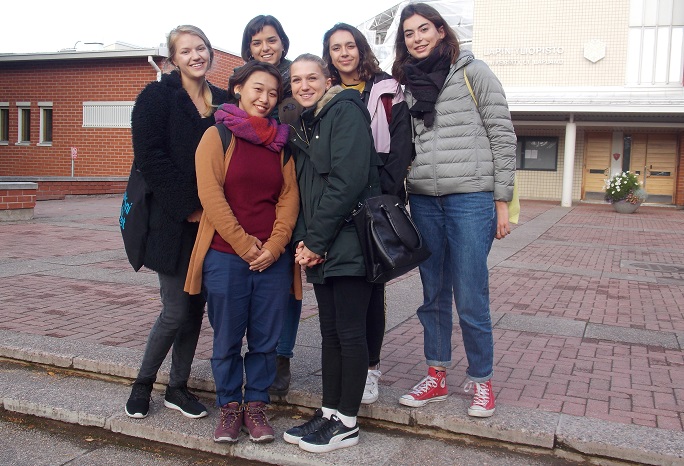Int´l mobility getting back to normal at universities gradually
Published : 03 Jul 2021, 03:21
Updated : 03 Jul 2021, 03:25
The volume of international mobility at higher education institutions is set to increase in autumn semester 2021 compared to the last year before, according to a survey addressed by the Finnish National Agency for Education to higher education institutions.
The survey conducted in early June, to which all 37 institutions responded, said the agency in a press release.
According to the higher education institutions’ estimates, almost 2,300 students are going on international student exchanges or traineeships in the autumn, whereas in autumn semester 2020, only slightly over 700 exchanges ultimately went ahead. Nevertheless, the number of outgoing students is still only about one half of the normal level.
The number of exchange students arriving in Finland is considerably higher than the number of outgoing students. A total of 4,850 students are expected to arrive in Finland, whereas in autumn semester 2020, the number of foreign exchange students at Finnish higher education institutions was 2,150.
The reported figures, however, are estimates that may still change due to the COVID-19 situation.
In autumn 2020, roughly one out of three higher education institutions cancelled all student mobility due to the COVID-19 pandemic. In the forthcoming autumn semester, however, their policies will take a much more positive stance on mobility.
Regarding outgoing student mobility, only one higher education institution that responded to the survey said that no exchanges would be arranged in the autumn, while another institution reported that it would only send out students completing a double degree.
Other higher education institutions intend to send students out on exchanges or traineeship periods if this is allowed by the restrictions put in place by the authorities in Finland and the destination countries and if the host institutions are willing to receive the students. Several higher education institutions specified in their responses that only long exchange periods of several months will go ahead in the autumn semester.
While incoming exchange students will outnumber outgoing ones by a considerably margin in the autumn, 11 higher education institutions have imposed restrictions on incoming students. For example, these institutions intend to limit the number of students they receive, or only receive double degree or postgraduate students, or students from the EU countries.
Some higher education institutions will insist that the students expressly undertake to comply with the rules and COVID-19 restrictions of the institution and Finland. Two higher education institutions do not intend to accept any incoming exchange students.
Teacher and staff mobility in higher education institutions came to a complete halt at the start of the COVID-19 pandemic almost 18 months ago. Now higher education institutions feel hopeful for the first time about being able to organise physical exchanges for outgoing and incoming staff members.
Higher education institutions estimate that during the autumn semester, staff exchange numbers may amount to 180 outgoing and 105 incoming teachers and staff members. The exchanges will go ahead if the COVID-19 situation makes it possible to resume business travel and if higher education institutions relax their travel instructions. Postponing the starting of staff mobility to the next semester may also turn out to be necessary.
Some virtual mobility of teachers and other staff has taken place during the pandemic, and this practice is also expected to continue in the autumn semester. Virtual staff mobility refers to using remote connections for teaching or for visits to a foreign higher education institution related to cooperation or on-the-job learning.
The COVID-19 pandemic has also taken a toll on international degree students at Finnish higher education institutions. Some new students admitted in 2020 were unable to arrive in Finland because of the pandemic; consequently, some of them postponed the start of their studies, while others stayed in their home countries and opted for distance learning.
Higher education institutions estimate that some of those who postponed their studies a year ago will arrive in Finland this autumn. On the other hand, some students admitted in the application process of 2021 may decide to postpone their studies by one year if they cannot enter the country due to restrictions on entry or problems in permit processes. Some may also stay in their home countries and go for distance learning, as this option is facilitated by many higher education institutions.
Respondents to the survey estimate that in general, distance learning arrangements have been effective, even if remote teaching is not possible in all fields and courses, including the arts and fields requiring laboratory or practical work, in particular.
While distance learning has been effective in technical terms for those studying in Finland, obvious impacts on student well-being have been observed. Some students have found distance learning lonely and stressful as there is less communality between students, especially among new students who did not get a chance for group formation before the COVID-19 outbreak.
It has also been noted that international students’ distance learning while based in their home countries has been fraught with challenges. These challenges include internet connections which may be poor or, especially in conflict zones, non-existent as well as problems caused by time differences. It has also been observed that these students are less committed to their studies than those studying remotely in Finland.
In the autumn semester, higher education institutions intend to opt for a hybrid model in the organisation of studies and provide both distance learning and contact teaching.
In particular, the institutions wish to offer as much contact teaching as possible for first and second-year students, and many higher education institutions hope to go back to contact teaching as soon as possible.


